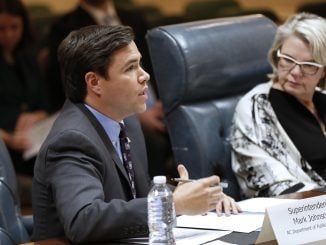
RALEIGH — North Carolina’s senate leader pitched improvements to public school laws designed to boost reading-proficiency rates among early-grade students.
Senate President Pro-Tem Phil Berger (R-Eden) said the latest “Excellent Public Schools Act” bill is more comprehensive than a similarly titled measure from 2019 that had strong bipartisan support but was vetoed by Democratic Gov. Roy Cooper. These bills are supposed to build upon the 2013 “Read to Achieve” law.
Berger said the latest bill adheres to the same objective as in 2013: increasing the number of students who can read at their grade level by the end of third grade.
“The data shows that reading comprehension by third grade has major impacts on a child’s future career and education prospects,” Berger said at a news conference previewing the measure, which was filed later Monday. “This bill enhances and facilitates bringing all components of a successful reading initiative to students needing help in mastering the critical skill needed for success in education.”
Key test results on fourth grade reading in North Carolina have been flat in recent years.
“Read to Achieve is working well in some places and needs adjustment in others. We want the best policies that put North Carolina students in a position to succeed,” Berger said.
Compared to the 2019 bill, the new measure expands by adjusting the curriculum for student teachers and training of pre-kindergarten and elementary school teachers toward a more phonics-based approach to reading instruction. Like the 2019 bill, early-grade students struggling with reading also would receive individualized improvement plans. Teachers could obtain bonuses for successful reading instruction outcomes, and more online reading resources would be available for parents.
Cooper vetoed the 2019 bill, saying the legislation tried “to put a Band-Aid on a program where implementation has clearly failed.” Berger suggested the veto was simply partisan. The initial 2019 bill actually was developed with a Cooper appointee on the State Board of Education.
Berger said he again anticipates Democratic support for this bill in his chamber. Reading, he added, “is one of those things that should not have a political component to it.”
The bill, which Berger said could have a Senate floor vote later this week, mandates literacy instruction training that follows what’s called “the Science of Reading,” in which phonics is a primary element. This method emphasizes the importance of sounds, spelling and other techniques to teach reading.
The method was challenged during the 20th century by what’s called a “look and say” or “whole language” method in which young children are taught to recognize whole words, rather than sounds.
Not all education leaders believe it’s clear cut what is the best method. But Superintendent of Public Instruction Catherine Truitt said on Monday that scientific evidence makes clear that phonics-style instruction is best for children and needs to be reinstituted. Other states have moved in that direction. The legislation directs the “Science of Reading” as required coursework within elementary school teacher college preparatory programs.
Sen. Deanna Ballard (R-Watauga), another bill sponsor, said results of recent literacy task forces involving the Department of Public Instruction and the UNC system about literacy have laid the groundwork for the shift.
Read to Achieve already includes “summer reading camps” for students at risk of failing. House Speaker Tim Moore pushed through his chamber last month a separate summer school program to assist students who have fallen behind during the COVID-19 pandemic. Berger said on Monday the Senate intends to take up Moore’s bill, too. It was scheduled for committee debate on Tuesday, along with Berger’s measure.



